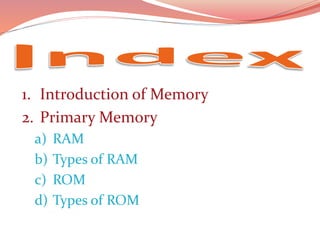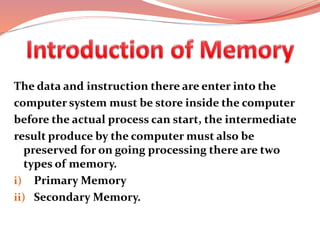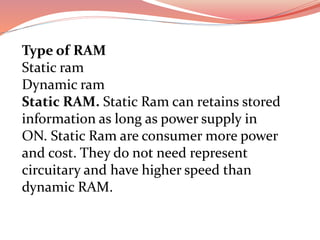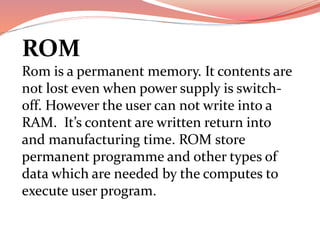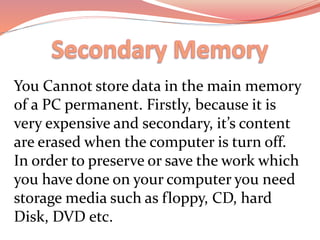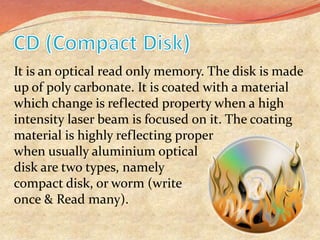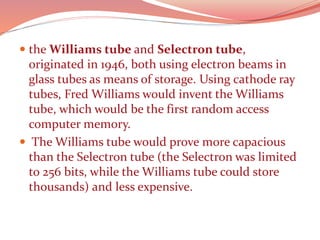Computer memory presentation
- 1. “A” Level Course of Software 7:30 to 9:00
- 2. I would like to express my special thanks of gratitude our Director Sir who gave me this opportunity to do this wonderful presentation. I would like to my teachers MR. AMARDEEP GULATI, MR. PRIYANK BANSAL and AJAY SIR, who always gave valuable suggestion and guidance for the completion of my presentation. They help me understand and remember important details of the presentation that I would have otherwise lost. I would like to thanks to MY PARENTS, without their cooperation, I have never been able to complete my presentation. I would like to thanks all those PEOPLES who have directly or indirectly helped me.
- 3. 1. Introduction of Memory 2. Primary Memory a) RAM b) Types of RAM c) ROM d) Types of ROM
- 4. 3. Secondary Memory a) Hard Disk b) Structure of Hard Disk c) Floppy Disk d) CD e) DVD f) Mass Storage
- 6. The data and instruction there are enter into the computer system must be store inside the computer before the actual process can start, the intermediate result produce by the computer must also be preserved for on going processing there are two types of memory. i) Primary Memory ii) Secondary Memory.
- 7. The main memory of a computer is design to cater to such needs. It provides space for storing data and instruction, space for storing intermediate results and also space for find result. In short, the specific function of main memory are to store the following: 1. All the data & instructions are proceed. 2. Intermediate result for processing 3. Final result before sending them to output device. Types of Main Memory 1. RAM (Ramdom Access Memory) 2. ROM (Read Only Memory)
- 8. Ram stands for Random access memory or read and write memory. Information can be return into and read form RAM. It is a volatile memory which means that it retain the stored information as long as the compute is connected to a power supply source. When power supply is switch-off the started information is the RAM is lost. RAM
- 9. Type of RAM Static ram Dynamic ram Static RAM. Static Ram can retains stored information as long as power supply in ON. Static Ram are consumer more power and cost. They do not need represent circuitary and have higher speed than dynamic RAM.
- 10. Dynamic RAM. Dynamic ram last is stored information in a very short time even RAM the power supply is ON. Therefore dynamic ram have to be refresh periodically generally every 2 mili-second. programmable ROM.
- 11. ROM Rom is a permanent memory. It contents are not lost even when power supply is switch- off. However the user can not write into a RAM. It’s content are written return into and manufacturing time. ROM store permanent programme and other types of data which are needed by the computes to execute user program.
- 12. There are many types of ROM: PROM, EROM, EEROM PROM (Programmable Read Only Memory). Programable ROM also availale different types of PROM such as erasable programmable ROM or EPROM and electrically erasable
- 13. You Cannot store data in the main memory of a PC permanent. Firstly, because it is very expensive and secondary, it’s content are erased when the computer is turn off. In order to preserve or save the work which you have done on your computer you need storage media such as floppy, CD, hard Disk, DVD etc.
- 14. A hard disk is a devices use for more storage of data. The data store on a hand disk can we store a very fast speed. It is a direct address devices. Unlike CD, floppy, etc, you can’t easily remove a hard disk from a PC.
- 15. Structure of Hard Disk A hard disk drive is made up of a group of disk or disk platter, piled on tap of one another in an either dust proof case.
- 16. Floppy disk is also called a disk or Diskette, A floppy disk is a removable storage disk use for storing data. It is called a floppy disk because the round film inside the disk plastic shell is flexible. You can take a backup of any important information from the hard disk in a floppy. This will present lose of information in the case hard disk file or is infected with virus. You can use a floppy disk to store and more data easily from one PC to another.
- 17. It is an optical read only memory. The disk is made up of poly carbonate. It is coated with a material which change is reflected property when a high intensity laser beam is focused on it. The coating material is highly reflecting proper when usually aluminium optical disk are two types, namely compact disk, or worm (write once & Read many).
- 18. DVD (Digital Video Disk or Digital Versatile Disk) disk provide more storage capacity than a CD ROM. The disk used with DVD drives are of the same diameter and thickness as traditional CDs. Like CDs, the DVD disk can tolerate dust, Dirt and Finger Print, DVD are use for storing audio and video entertainment such movies, videos games and software application.
- 19. USB flash drives or pen drive Are Flash memory data storage Device integrated with a USB interface they typically small light weight, removable and rewritable. It is a flash Memory card that plug into the computer USB port.
- 21. Random access memory (RAM) is the best known form of computer memory. The opposite of RAM is serial access memory (SAM). SAM stores data as a series of memory cells that can only be accessed sequentially (like a cassette tape). SAM works very well for memory buffers, where the data is normally stored in the order in which it will be used.
- 22. Volatile Memory Volatile memory is computer memory that requires power to maintain the stored information. Most modern semiconductor volatile memory is either static RAM (SRAM) or dynamic RAM (DRAM).
- 23. Non-volatile memory Non-volatile memory is computer memory that can retain the stored information even when not powered. Examples of non- volatile memory include ROM, flash memory, hard disk drives, floppy disks and magnetic tape, optical discs. Virtual memory Virtual memory is a system where all physical memory is controlled by the operating system. When a program needs memory, it requests it from the operating system. The operating system then decides what physical location to place the memory in.
- 24. The following are some common types of RAM: SRAM: Static random access memory uses multiple transistors, DRAM: Dynamic random access memory FPM DRAM: Fast page mode dynamic random EDO DRAM: Extended data-out dynamic random access memory. Maximum transfer rate to L2 cache is approximately 264 MBps.
- 25. SDRAM: Synchronous dynamic random access memory . Maximum transfer rate to L2 cache is approximately 528 MBps. DDR SDRAM: Double data rate synchronous dynamic RAM. Maximum transfer rate to L2 cache is approximately 1,064 MBps (for DDR SDRAM 133 MHZ). RDRAM: Rambus dynamic random access memory Credit Card Memory: Credit card memory is a proprietary self-contained DRAM memory module that plugs into a special slot for use in notebook computers.
- 26. PCMCIA Memory Card: Another self- contained DRAM module for notebooks, CMOS RAM: CMOS RAM is a term for the small amount of memory used by your computer VRAM: Video RAM, also known as multiport dynamic random access memory (MPDRAM), is a type of RAM used specifically for video adapters or 3-D accelerators
- 27. Need of RAM For run computer fast For Window XP 64 or 128MB For Optimal Performance with standard computer application, 256 MB If you running window 95/98 you need a bare minimum 32 mb but not run good, then you need to add 64 mb ram for work much better.
- 28. Volatile Memory RAM Williams-Kilburn Tube (1946-47) Delay Line Memory-1947) Selectron Tube (1953) Dekatron
- 29. Non-Volatile ROM Mask ROM PROM EPROM EEPROM Hard drives Magnetic tape Hard disk drive Optical disc drive
- 30. Paper data storage (1725) Drum memory (1932) Magnetic-core memory (1949) Plated wire memory (1957) Core rope memory (1960s) Thin-film memory (1962) Twistor memory (~1968) Bubble memory (~1970)
- 31. In the early 1940s, memory technology mostly permitted a capacity of a few bytes. The first electronic programmable digital computer, the ENIAC, using thousands of octal-base radio vacuum tubes The next significant advance in computer memory came with acoustic delay line memory, developed by J. Presper Eckert in the early 1940s. through the contruction of a glass tube with filled with murcury and quartz crystal.
- 32. the Williams tube and Selectron tube, originated in 1946, both using electron beams in glass tubes as means of storage. Using cathode ray tubes, Fred Williams would invent the Williams tube, which would be the first random access computer memory. The Williams tube would prove more capacious than the Selectron tube (the Selectron was limited to 256 bits, while the Williams tube could store thousands) and less expensive.
- 33. As Efforts began in the late 1940s to find non-volatile memory. Jay Forrester, Jan A. Rajchman and An Wang developed magnetic core memory, which allowed for recall of memory after power loss.
- 35. Created By:


